Largest 100% Clean Energy Microgrid Within U.S. Department of Defense Supports Island Community, Pacific Missile Range Facility, KIUC, and Hawaii’s Ambitious Renewable Energy Goals
 U.S. Navy, KIUC, AES, and NREL Innovate and Collaborate for Resilience and Cost-Effective Clean Energy Project on Kauai
U.S. Navy, KIUC, AES, and NREL Innovate and Collaborate for Resilience and Cost-Effective Clean Energy Project on Kauai

Case Study from | NREL
For more than a decade, the National Renewable Energy Laboratory (NREL) has partnered with the U.S. Department of the Navy to support clean energy and resilience at installations across the globe. One of the latest successful, groundbreaking projects was completed at the U.S. Navy's Pacific Missile Range Facility (PMRF), located on the west side of the Hawaiian island of Kauai.
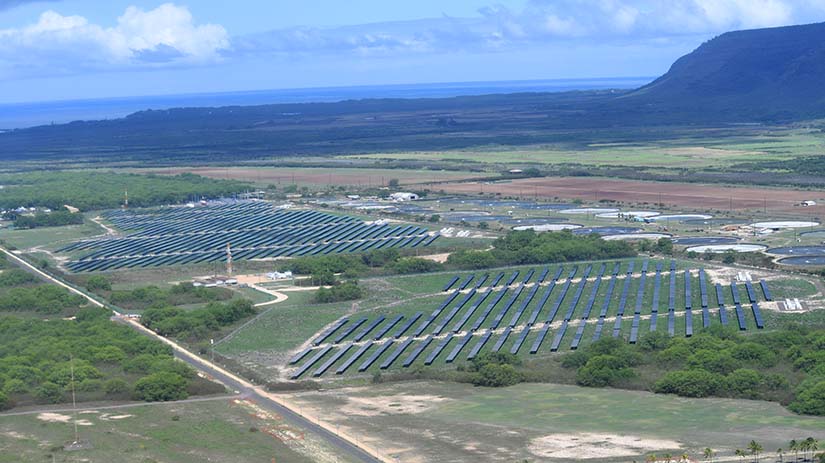
The U.S. Navy's Pacific Missile Range Facility includes a 14-megawatt solar facility paired with a 70 megawatt-hour battery energy storage system sited on the base. Photo courtesy of U.S. Navy
The collaborative effort brought together the U.S. Navy; the Kauai Island Utility Cooperative (KIUC), the island's electric utility; AES, a global energy company; and NREL, among others.
Years ago, an NREL team member on assignment with the Navy at Pearl Harbor worked with stakeholders to catalyze the project concept as part of the Navy's initiative to deploy 1 gigawatt (GW) of distributed energy resources to support energy resilience. The Navy issued a request for proposals (RFP), which was awarded to KIUC, and subsequently KIUC issued an RFP for project development awarded to AES. During the course of the engineering and construction process, AES sought to leverage the one-of-a-kind microgrid validation facilities at NREL's Flatirons Campus in Colorado to configure, integrate, tune, and validate the microgrid operational capabilities prior to implementation at PMRF, saving time and reducing risk.
Among many benefits, this project enhances PMRF's capabilities to become self-sufficient for all its electricity needs in the event of a loss of transmission feed from the utility grid. PMRF can now leverage a 14-megawatt (MW) solar facility paired with a 70 megawatt-hour (MWh) battery energy storage system sited on the base.
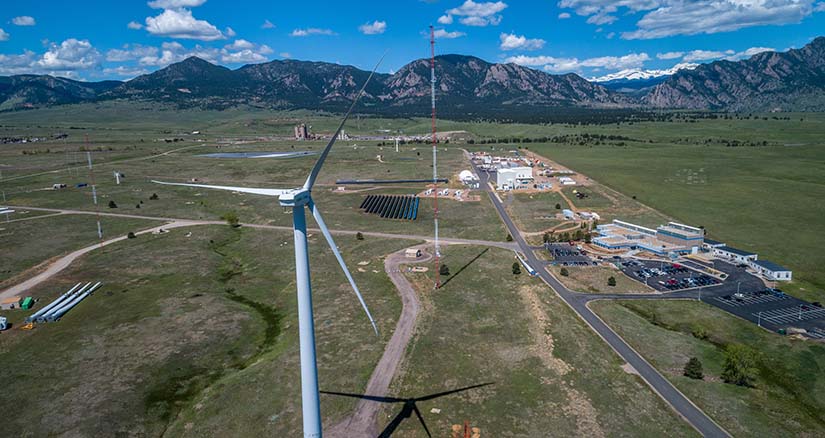
NREL's Flatirons Campus near Boulder, Colorado, includes one-of-a-kind microgrid validation facilities. Photo by Joshua Bauer, NREL
High-Tech Simulation and Validation Saves Time and Cost
Large, clean energy microgrids to support energy resilience are growing in number and technological innovation. One of several innovations in this case was AES' development of a new microgrid control strategy with automatic fast frequency and voltage response, made possible by advanced DC-coupled architecture and advanced power-electronics control. Evaluation and validation capabilities at NREL's Flatirons Campus allowed the team to cost-effectively and safely evaluate a wide variety of simulated events and conditions at PMRF on the leading edge of renewable energy technology development.
"At the Flatirons Campus, we have many hardware components to enable technology validation," said Przemyslaw Koralewicz, the NREL grid integration engineer who led the technology validation and evaluation. NREL's controllable grid interface allows for evaluation of electrical components and systems under varying conditions and allows public and private partners to quickly and cost-effectively validate new innovative technologies as a system. In this case, Koralewicz added, "Power hardware in the loop is a great capability that we use to show how the system we have installed at Flatirons Campus will integrate with the electrical system on the island of Kauai."
The Navy's PMRF manages the world's largest instrumented training and test range, covering more than 1,100 square miles of instrumented underwater range and over 42,000 square miles of controlled airspace, with a temporary operating area of 2.1 million square miles when needed for missile testing. The first-of-its-kind microgrid that AES developed and installed on Kauai serves to provide electric power resiliency to the base. As a result, the system ensures the installation has power in case of a loss of the transmission feed from the utility grid, which could happen during a severe weather event for instance.
"This partnership allows PMRF to have direct access to the power source, resulting in reliable and clean grid power while simultaneously reducing reliance on diesel generators," stated Lt. Commander Terence White, PMRF Public Works Officer. "This Enhanced Use Lease [EUL] project better supports DOD testing and evaluation objectives by utilizing PMRF's new grid consolidation infrastructure to increase resiliency—through both planned and unplanned events. Overall, this EUL project is capable of meeting the robust electrical requirements needed to support the critical test and training mission here at PMRF."
As an additional feature, the solar-plus-energy-storage system and the substation are designed with the ability to "black start." If the transmission feed from the utility grid goes down, this resilient energy system can still provide power for the base and start itself without requiring an emergency diesel generator; it can start just by using the power from its own solar array and batteries.
"AES made significant cost-effective advancements in the microgrid controls using the DC-coupled solar-plus-storage architecture to manage the transition to and from electrically islanded operation," said Chris Boyer, AES director of product solutions. "We are now able to use this innovation in other projects across the globe."
This partnership project also aligns with the Advanced Research on Integrated Energy Systems (ARIES), a research platform that can match the complexity of the modern energy system and conduct integrated research to support the development of groundbreaking new energy technologies.
In addition to several technological innovations, the project team enhanced the construction schedule.
"What's typically happened in other microgrid projects is there's a long commissioning period while the controls get ironed out," Boyer said. "This would be really expensive on Kauai, and it could have taken months before all the controls were tuned and doing what they're supposed to do through every imaginable event. What we did was take all those months of time to tune the controls and paralleled them with our construction period, so, while construction was taking place at the base, we were evaluating the controls and event responses at NREL's Flatirons Campus. When it came time to validate these controls on-site, it only took us about one month to complete the final configurations and tuning. All the methodologies for the on-site tuning and validation were figured out at NREL first."
The PMRF microgrid project is a prime example of how all parties involved were able to foster innovative solutions by working together with focused, dedicated teams. The creative contracting mechanism used for this project, an enhanced use lease, enabled the Department of the Navy, KIUC, AES, NREL, and others to build partnerships that supported the mission and goals of many stakeholders. KIUC was awarded the initial performance-driven request for proposals by offering to provide electricity to the Navy during an emergency and construct a new substation on base. In return, KIUC was able to lease a secure site to locate a new solar array and battery energy storage system (BESS) that could benefit island stakeholders. KIUC issued a request for proposals for the project development, which AES won. Under normal conditions, KIUC uses the system to provide cost-effective, clean energy to the island community, in addition to the base.
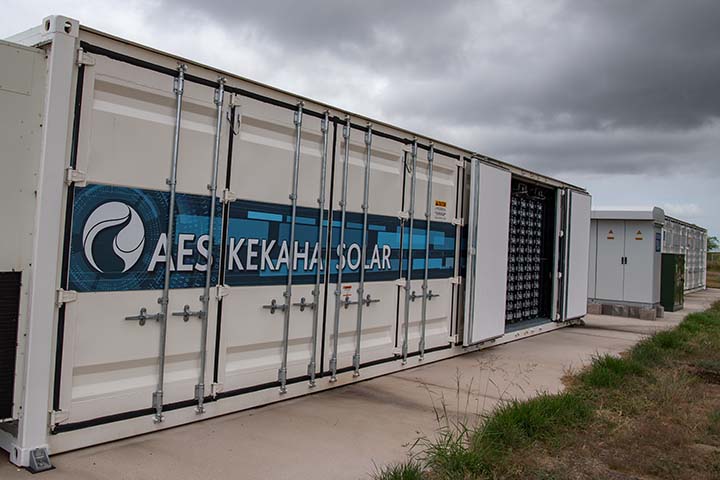
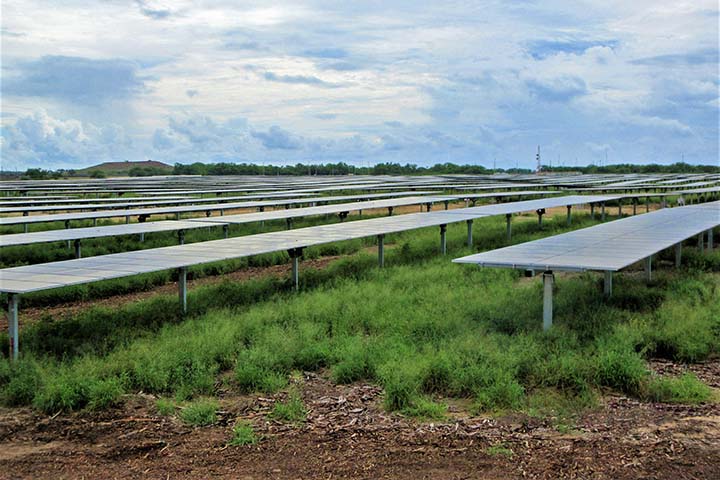
An energy storage system developed and installed by AES ensures the installation has power in case of a loss of the transmission feed from the utility grid. Photos courtesy of U.S. Navy and AES
"This is a great example of the power of strong partnerships supporting innovation and clean energy system deployment," stated Mike Callahan, NREL Applied Engineering group manager, who supported this and other Department of the Navy resilient energy projects for more than a decade. "With this and other projects, the Department of Navy, KIUC, AES, and the island of Kauai and NREL are collectively demonstrating leadership to advance clean energy systems integration and resilience. Today, the entire island of Kauai operates routinely on 100% renewable energy, primarily solar, and the base now has an on-site power source that isn't dependent on fuel shipments."
Marching Toward Renewable Energy Goals and Investing in the Community
"Our mission is to improve lives and to create a 100% carbon-free future, so we really pride ourselves on our holistic focus on sustainability, communities, and innovation," said Leo Moreno, president of AES Clean Energy, during a virtual tour of the project hosted by the Navy in mid-May. "This is an excellent project to demonstrate these three objectives."
Moreno also highlighted that this is a win-win for the utility and its customers. When the base does not need the microgrid, KIUC uses it to power the island community.
A Promising Outlook for Partnerships and Renewable Energy
"The power system is running with the batteries, and the solar system is being used daily by KIUC," Koralewicz said. "They already demonstrated the advanced microgrid capabilities."
Koralewicz added that the PMRF project is one of several projects where NREL is supporting AES. "We will continue to partner with AES and others to help develop technology innovations. It is great to support an industry partner's efforts to develop a technology, validate it, and then watch them scale it to many more projects across the globe."
AES has been busy deploying innovative renewable energy in Hawaii, beyond the PMRF microgrid, to meet the state's goals for reliable, clean energy. In late 2018, AES installed the 28-MW PV and 100-MWh BESS Lāwai Solar and Energy Storage project on Kauai. In January 2021, AES and KIUC again joined forces after a competitive solicitation process, this time on Kauai's first solar and pumped-storage hydro project, known as the West Kauai Energy Project.
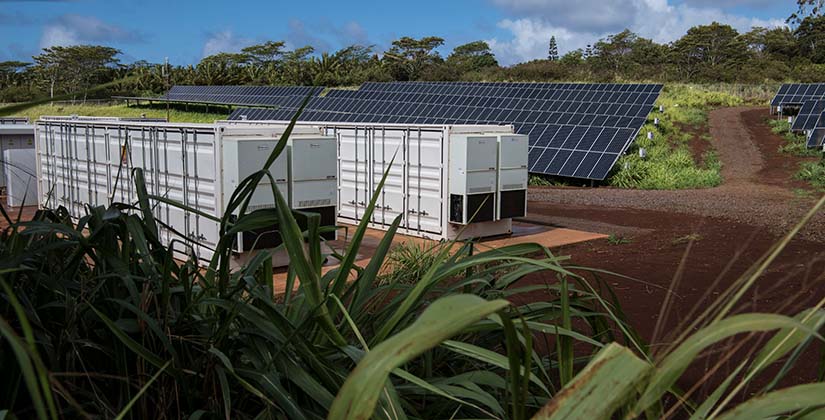
In 2018, AES installed the world's largest solar-plus-storage system on the southern end of the Hawaiian island of Kauai. A scaled-down version was first tested at NREL. Photo by Dennis Schroeder, NREL
AES, KIUC, and the Navy are just three of approximately 250 unique NREL partners, from which more than 900 active agreements have come with over $100 million in annual agreement value. With AES, NREL has already successfully partnered on some U.S. Department of Energy (DOE) proposals where, together, they will focus their work on fundamental science.
For the Department of Defense, Deputy Assistant Secretary of Defense for Environment and Energy Resilience Richard Kidd gave those attending the Navy's mid-May virtual open house a look into a very bright future with great potential ahead.
"The department has a longstanding history of cooperation with DOE," Kidd said. "We have NREL staff working for every service. We leverage the assets of the interagency, but particularly DOE. Right now, across the department, we have fantastic projects like this numbered in the dozens, but we have opportunities in the hundreds, if not thousands."
Self-sufficient, secure, advanced microgrids like this one at PMRF have potential to provide energy resilience and are scalable across diverse applications. Proven and impactful partnerships such as this, between the Navy, KIUC, AES, and NREL, set the stage for acceleration of the future of energy resiliency and clean energy.
Learn more about NREL's partnership with the U.S. Department of Defense.
The content & opinions in this article are the author’s and do not necessarily represent the views of AltEnergyMag
Comments (0)
This post does not have any comments. Be the first to leave a comment below.
Featured Product

